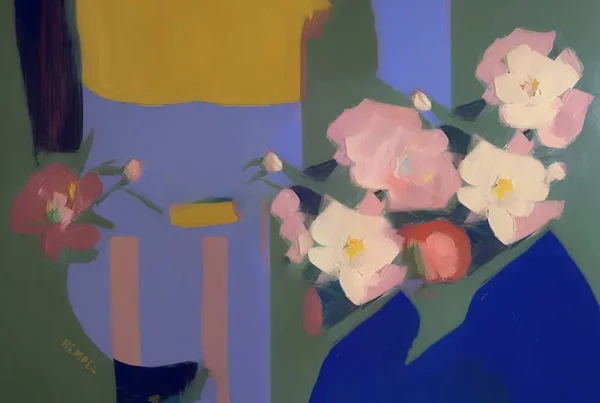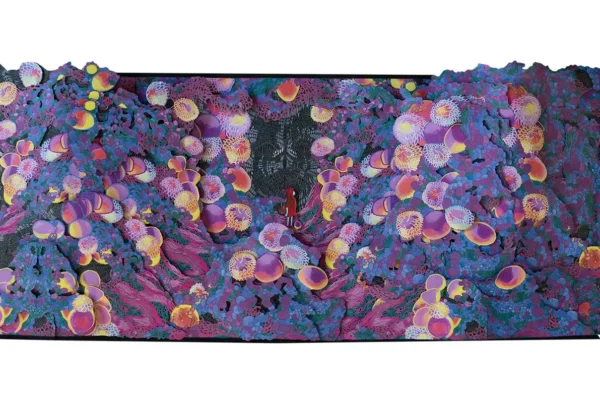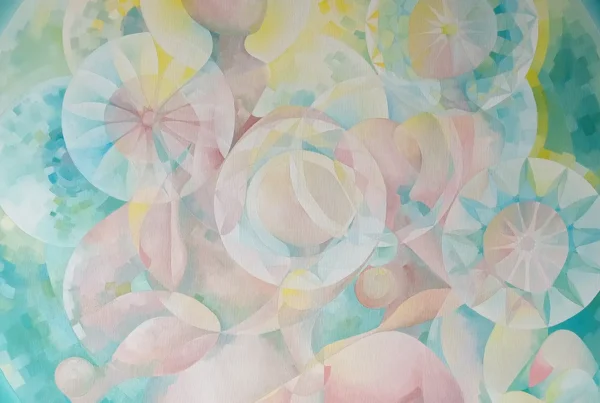“The structures and freedom of music took root in me, becoming the crucible for the painting style for which I am known today.”
A Shaped Identity: The Influences of a Restrictive Upbringing
Born in 1961 in Hertfordshire, UK, HAYDN emerged from an artistic family whose creative dynamics were as tumultuous as they were formative. His mother, a classically trained artist and teacher, crafted exquisite works in oils and watercolors. Her detailed drawings reflected her mastery of anatomy and perspective, traits that subtly influenced her shy, reticent son’s developing artistic lens. In contrast, HAYDN’s father, an amateur pianist obsessed with classical music, dominated the household with his overbearing personality. His authoritarian tendencies stifled the family, drowning the home in a constant surge of orchestral compositions played at deafening volumes.
In this high-pressure environment, HAYDN found refuge in art and music, excelling in both from an early age. He drew detailed portraits of birds, particularly birds of prey, symbols of the freedom he longed for amidst his restricted upbringing. Music also became a solace, and his father’s influence led him to master advanced classical piano works at a young age. However, tension marred even his artistic successes, as his father belittled his explorations into progressive styles of painting, dismissing them as “pseudo-impressionism.” This critique stung deeply, causing HAYDN to abandon painting for years, even as a passion for visual art simmered beneath the surface.
Despite his father’s insistence on a musical path, HAYDN’s artistic flame was reignited in the 1980s when he encountered the searingly powerful, emotionally charged works of Francis Bacon at the Sainsbury Centre for Visual Arts, in Norwich, UK. This transformative moment planted a seed that would later bloom into his full commitment to art. His journey, however, was far from linear, as paternal expectations led him into a celebrated yet ultimately disillusioning career as a classical pianist.

HAYDN: From Concert Hall to Canvas
In the early 2000s, a period of personal and health crises forced HAYDN to reevaluate his trajectory. Disenchanted with the restrictive norms of the classical music world and yearning for greater creative freedom, he revisited his early love for painting. Encouraged by artist friends and driven by an unrelenting creative urge, he immersed himself in the world of visual art. This shift marked the beginning of a new chapter, one where his expressive style as a pianist began to inform the fluid, dynamic gestures of his paintings.
HAYDN’s work quickly evolved into an exploration of abstraction, characterized by bold gestural movements and vivid color palettes. His creations are imbued with the energy of the great masters he admired as a child, seamlessly blending classical influences with the spontaneity of abstract expressionism. Music remained an essential element, inspiring a rhythm and fluidity that critics have often likened to the arching phrases of music from Bach through to free jazz.
Represented by Iologies Fine Art, where HAYDN’s work may be purchased, his paintings found homes in collections across Europe, the United States, Scandinavia, and Asia. This global resonance attests to the universal appeal of his work, which channels deeply personal experiences into compositions that evoke a range of emotions and interpretations.

The Dance of Abstraction: Themes and Inspirations
HAYDN’s artistic practice resists easy categorization, though abstract expressionism often serves as a useful descriptor. His canvases explore themes of freedom, confinement, elation, despair, and much more, often tinged with resonances of the natural world. Each piece invites viewers to find their own meanings within the interplay of color, form, and texture. Music remains a profound influence, with his works often described as visual equivalents of musical improvisation. This connection between auditory and visual creativity is no coincidence; for HAYDN, painting is as much about rhythm and flow as it is about color and composition.
Despite his affinity for abstraction, HAYDN reveres the work of the great masters from Michelangelo and Rembrandt through to Cézanne, Van Gogh and beyond. No art exists in a vacuum and HAYDN pays subtle and constant homage to towering artists from the past without a trace of nostalgia. His canvases are vibrant, contemporary, and unbound by the constraints of traditional representation.
One particularly meaningful work for HAYDN is Pablo Picasso’s DISH OF PEARS (1936), housed at Tate Modern. This seemingly simple painting captivates him with its fluidity and musicality, as well as the artist’s evident joy in embellishing the frame. For HAYDN, it exemplifies how art can transcend medium and genre to convey something deeply sensual.

HAYDN: A Studio Where Art and Meditation Collide
HAYDN’s studio is a sanctuary of creativity, filled with the echoes of past triumphs and failures. A man of modest creative needs, he eschews sophisticated tools and resources in favor of simplicity. His work is often executed using simple brushes and an antique German painting knife, a talismanic object imbued with familial history. Large canvases are affixed directly to the wall, bypassing the conventional use of easels. For HAYDN, this method allows him to confront his canvases full on as if they were a mirror which, metaphorically, they often are.
Pinned to the studio walls are postcards of iconic artworks and exhibition mementos, serving as both inspiration and silent companions during his creative process. The space is an extension of his philosophy that art is a meditative practice, one that requires an intimate dialogue between the artist and the canvas. Even before a single mark is made, HAYDN describes the act of simply observing the blank surface as an integral part of his creative ritual.
In his creative cocoon, distractions are rare. Painting, for HAYDN, is a form of transcendence—a state of being where time and external concerns dissolve. This disciplined focus allows him to channel his intuition fully, letting his subconscious guide the strokes and colors that define his expressive, emotionally charged works.
“The Art of Haydn Dickenson is like a true symphony, whose depth in all its diverse movements, inner ‘nerve’, expressive energy, live creative impulse, artistic passion and constant search take us beyond reality into spheres of the infinite. These are works that resonate with the heartbeat of life.” (Dasha Balashova, Artist)






